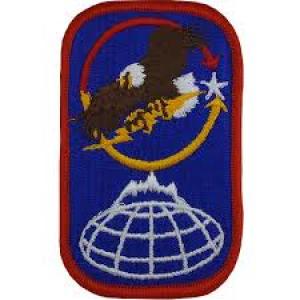Всемирная военная энциклопедия
> США
> Нашивки
> Нарукавные нашивки Сухопутных войск
> Другие нарукавные знаки пронумерованных подразделений
> US-PTMNU-00022

Нарукавный знак 100 бригады противоракетной обороны СВ США
Случайные:

Нарукавный знак 35 бригады связи СВ США

Nutria Bush Hat

Эмблема на берет 1-го гренадерского эскадрона Французкого Иностранного легиона
Редактировать или перевести информацию
Description
On a Blue vertical rectangle, arched on top and bottom, embroidered device 3 1/2 inches (8.89 cm) in height and 2 1/2 inches (6.35 cm) in width overall, edged with a 1/8 inch (.32 cm) Red border, above a globe crowned with a stylized snow capped mountain range, an American Bald Eagle swooping grasping a lightning bolt bendwise sinister Yellow, surrounded by two arching contrails emitting from dexter flank one arcing in chief Red, and one arcing in base Yellow, both barbed and meeting at a mullet Argent, in sinister flank.
Symbolism
Scarlet and yellow are the colors traditionally associated with Air Defense Artillery. The two colliding arching arrows represent ground-based interceptor (GBI) meeting intercontinental ballistic missile (ICBM) and the exhaust contrails form the letter “C,” which is the Roman Numeral for “100,” the unit’s numerical designation. The white star represents Northern Command and is a traditional symbol of the Army. It is also the starting point of the circular direction of the arrows that symbolize the global range of defense, and encircles the globe symbolizing the worldwide defense of the unit and relates to parent unit U.S. Army Space and Strategic Defense Command/U.S. Army Space and Missile Defense Command (ARSTRAT/SMDC). The mountains replicate those found on the Colorado State Seal, the Brigade’s original headquarters. The attacking eagle grasping a lightning bolt is representational of the unit’s motto, “Contegamus et Cassamus,” (Guard and Destroy),” which directly relates to the daily operations of the Brigade, remaining vigilant and on guard, while destroying threat clusters in their mission of National Defense.
Background
The shoulder sleeve insignia was approved on 5 January 2005. (TIOH Drawing Number A-1-868)
On a Blue vertical rectangle, arched on top and bottom, embroidered device 3 1/2 inches (8.89 cm) in height and 2 1/2 inches (6.35 cm) in width overall, edged with a 1/8 inch (.32 cm) Red border, above a globe crowned with a stylized snow capped mountain range, an American Bald Eagle swooping grasping a lightning bolt bendwise sinister Yellow, surrounded by two arching contrails emitting from dexter flank one arcing in chief Red, and one arcing in base Yellow, both barbed and meeting at a mullet Argent, in sinister flank.
Symbolism
Scarlet and yellow are the colors traditionally associated with Air Defense Artillery. The two colliding arching arrows represent ground-based interceptor (GBI) meeting intercontinental ballistic missile (ICBM) and the exhaust contrails form the letter “C,” which is the Roman Numeral for “100,” the unit’s numerical designation. The white star represents Northern Command and is a traditional symbol of the Army. It is also the starting point of the circular direction of the arrows that symbolize the global range of defense, and encircles the globe symbolizing the worldwide defense of the unit and relates to parent unit U.S. Army Space and Strategic Defense Command/U.S. Army Space and Missile Defense Command (ARSTRAT/SMDC). The mountains replicate those found on the Colorado State Seal, the Brigade’s original headquarters. The attacking eagle grasping a lightning bolt is representational of the unit’s motto, “Contegamus et Cassamus,” (Guard and Destroy),” which directly relates to the daily operations of the Brigade, remaining vigilant and on guard, while destroying threat clusters in their mission of National Defense.
Background
The shoulder sleeve insignia was approved on 5 January 2005. (TIOH Drawing Number A-1-868)
Еще из категории: Другие нарукавные знаки пронумерованных подразделений
 Нарукавный знак 7 командования гражданского корпуса охраны тыловых объектов СВ США
Нарукавный знак 7 командования гражданского корпуса охраны тыловых объектов СВ США
 Нарукавный знак 98 учебной дивизии СВ США.
Нарукавный знак 98 учебной дивизии СВ США.
 Нарукавный знак 2 полевой армии СВ США во Вьетнаме
Нарукавный знак 2 полевой армии СВ США во Вьетнаме
 Нарукавный знак штаба 51 командования СВ США.
Нарукавный знак штаба 51 командования СВ США.
 Нарукавный знак 76 командования оперативных сил (оперативного реагирования) резерва СВ США
Нарукавный знак 76 командования оперативных сил (оперативного реагирования) резерва СВ США


